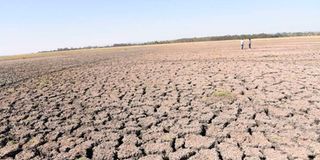Rallying cry to stop EWaso Ng’iro wetlands from drying up

A dried part in the middle of Lake Olbolosat in Nyandarua County as a result of siltation following destruction of forests and other human activities at Aberdare Ranges.
What you need to know:
- The wetlands are key to the survival of River Ewaso Ng’iro but are facing threats due to human activities. River Ewaso Ng’iro’s has been declining in volume despite supporting more than two million people, livestock and wildlife in four northern Kenya counties.
- Previous pledges by government agencies to protect these wetlands have yet to be actualised, with fears that the interventions might come a little too late.
Environmentalists have called for urgent measures to preserve wetlands in the Ewaso Ng’iro catchment area to protect rivers from drying up in the face of a ravaging drought.
The wetlands include Lake Olbolosat in Nyandarua County, Ewaso Narok Swamp in Laikipia County, and Kabeere and Gabera springs in Meru and Isiolo counties respectively. They play critical ecosystem roles, acting as water sources and helping in flood control and water purification.
The wetlands are key to the survival of River Ewaso Ng’iro but are facing threats due to human activities. River Ewaso Ng’iro’s has been declining in volume despite supporting more than two million people, livestock and wildlife in four northern Kenya counties.
Previous pledges by government agencies to protect these wetlands have yet to be actualised, with fears that the interventions might come a little too late. For instance, Lake Olbolosat was gazetted as a protected wetland in 2018 under the Environmental Management and Coordination Act and a management plan developed. Four years later, the threats facing the lake, which forms the headwaters of River Ewaso Ng’iro, persist.
The threats
According to Water Resources Authority (WRA), a government agency mandated to conserve water sources, the lake size reduced by 68 per cent between 1989 and 2010. With the ongoing drought, it has dried up by over 50 per cent in the last few months.
Threats to its survival include human encroachment, illegal abstraction from feeder rivers and springs, deforestation, unplanned grazing patterns and climate change effects.
“Whereas the farmland build-up has increased by up to 33 per cent between 1989 and 2010, the lake size has reduced by up to 68 per cent within the same period. Similarly, the floodplain is estimated to have reduced by about 26 per cent,” says a report from Mr John Kinyanjui, WRA’s water resources assessment and monitoring manager.
Lake Obolosat Water Resource Users Association Chairman Samuel Ngari says if urgent interventions are not made, the lake will be history in a few years. “In the past years, this lake was a tourist-attraction site and visitors could flock to see wild animals. With the receding water levels witnessed in recent years, the animals are no longer here except hippos, which are a cause of f human/wildlife conflicts.”
Mr Ngari adds that senior government officials, including Environment Cabinet Secretary Keriako Tobiko, have visited the lake and promised interventions, including fencing off the lake and de-silting it, but nothing has been done so far.
Ministry of Lands Principal Secretary Nicholas Muraguri recently announced plans to rehabilitate the lake through a multimillion-shilling project that would include evicting encroachers.
While this development has been welcomed by conservationists, there is little to celebrate at Ewaso Narok Swamp, which occupies more than 4,000 acres near Rumuruti town in Laikipia County and is home to 148 plant species, 127 bird species and 13 mammal species, according to a document from National Museums of Kenya compiled in 2020.
“This swamp has witnessed an influx of farmers who divert waters to their farms. There are no regulatory mechanisms to control diversion, hence the need to control water use by influential people to revert it to its former status,” says Mr Nakokoya Lakuyaan a community elder.
A report prepared jointly by the National Environment Management Authority (Nema), Laikipia County and United Nations Food and Agriculture Organisation states that about 30,000 people have encroached on the wetland to engage in farming for commercial and subsistence purposes. They are attracted by land fertility and water availability.
River Ewaso Ng’iro passes through this swamp then through Samburu and Isiolo counties to Lorian Swamp, from where it flows underground and emerges in Somalia and eventually flows into the Indian Ocean.
The decline in volume stretches from the swamp to Buffalo Springs in Samburu County where it gets boosted by waters flowing down from a well-conserved natural water source inside a wildlife conservancy. Nema’s Laikipia County director Jackson Muturo says the most serious threat facing Ewaso Narok Swamp is abstraction in the sub-catchment area, with 414 large-scale commercial irrigators drawing water from its feeder rivers.
Mr Muturo says the area was to be gazetted as a protected area, but the process is facing resistance, with a group of farmers having petitioned court to it, arguing public participation was not carried out properly.
A 10-year integrated management plan was recently launched, which, if implemented, will see farmers evicted and the swamp rehabilitated. The plan will be implemented through joint efforts of the government, development partners and non-governmental organisations.
A report after completion of a four-day 100km Camel Caravan last month, which aimed at sensitising communities to conserve the Ewaso Ng’iro River ecosystem, recommends declaration of wetlands as protected areas that should be fenced off to avoid encroachment.
“Lake and swamp areas need to be marked properly and gazetted as protected areas to support people and wildlife in the downstream of River Ewaso Ng’iro. Communities living next to the wetlands need to be sensitised to conserve the river’s ecosystem and be supported so that they can benefit from the eco-tourism to stop over-reliance on farming,” says John Ting’oi from Impact, the organisation behind the annual Camel Caravan.





